Oceanic Whitetip Shark
Carcharhinus longimanus
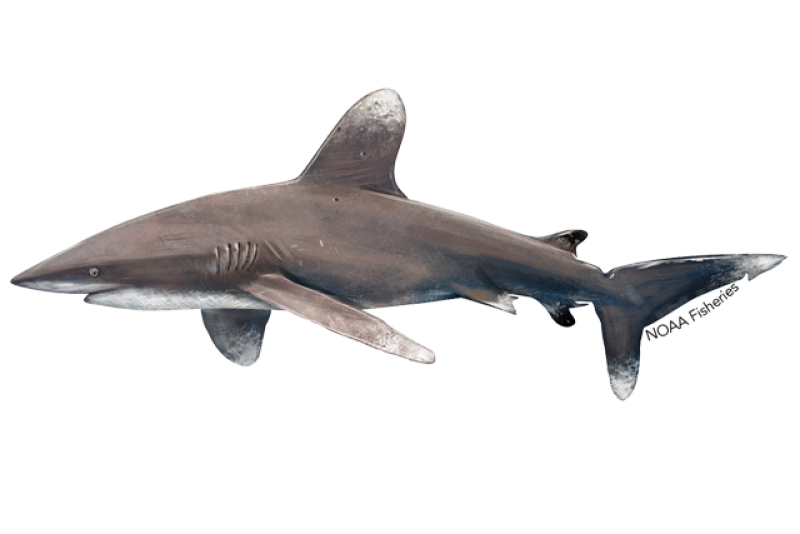
Protected Status
Quick Facts
 Oceanic whitetip shark. Credit: NOAA Fisheries
Oceanic whitetip shark. Credit: NOAA Fisheries
Oceanic whitetip shark. Credit: NOAA Fisheries
About the Species
 Oceanic whitetip shark. Credit: NOAA Fisheries
Oceanic whitetip shark. Credit: NOAA Fisheries
Oceanic whitetip shark. Credit: NOAA Fisheries
Oceanic whitetip sharks are large, pelagic sharks found in tropical and subtropical oceans throughout the world. They live offshore in deep water, but spend most of their time in the upper part of the water column near the surface. Oceanic whitetip sharks are long-lived, late maturing, and have low to moderate productivity.
The main threat to oceanic whitetip sharks is bycatch in commercial fisheries combined with demand for its fins. They are frequently caught in pelagic longline, purse seine, and gillnet fisheries worldwide and their fins are highly valued in the international trade for shark products. As a result, their populations have declined throughout its global range. In 2018, NOAA Fisheries listed the species as threatened under the Endangered Species Act.
Population Status
Information on the global population size of the oceanic whitetip is lacking. However, several lines of evidence suggest that the once common and abundant shark has experienced declines of potentially significant magnitude due to heavy fishing pressure. For example, the oceanic whitetip has declined by approximately 80 to 95 percent across the Pacific Ocean since the mid-1990s, though there may be some recent positive population growth in this region due to targeted management actions for this species. Substantial abundance declines have also been estimated for the Atlantic Ocean, including an 88 percent decline in the Gulf of America (formerly Gulf of Mexico) due to commercial fishing. However, in the greater Atlantic, the population may be stable due to fishery management actions and regulations since the early 1990s. Given their life history traits, particularly their late age of maturity and low reproductive output, oceanic whitetip sharks are inherently vulnerable to depletions, with low likelihood of recovery. Additional research is needed to better understand the population structure and global abundance of the oceanic whitetip shark.
Appearance
Oceanic whitetip sharks are large-bodied sharks with a stocky build, and have a distinctive pattern of mottled white markings on the tips of their dorsal, pectoral, and tail fins. These markings are why they are called “whitetip” sharks. Their dorsal fins are rounded and their pectoral fins are long and paddle-like. The color of their bodies varies depending on where they live. They are generally-grayish bronze to brown, while their undersides are whitish with some individuals having a yellow tinge.
Behavior and Diet
The oceanic whitetip shark is considered a top predator, eating at the top of the food chain. They are opportunistic, feeding primarily on bony fish and cephalopods, such as squid. However, they also reportedly feed on large pelagic sportfish (e.g., tuna, marlin), sea birds, other sharks and rays, marine mammals, and even garbage.
Where They Live
The oceanic whitetip shark is found throughout the world in tropical and sub-tropical waters. It is a pelagic species, generally found offshore in the open ocean, on the outer continental shelf, or around oceanic islands in deep water areas. Although they can make deep dives and have been recorded in depths to 1,082 meters (3,549 feet), they typically live in the upper part of the water column, from the surface to about 200 meters (656 feet deep). Oceanic whitetip sharks have a strong preference for the surface mixed layer in warm waters above 20°C, and are therefore considered a surface-dwelling shark.
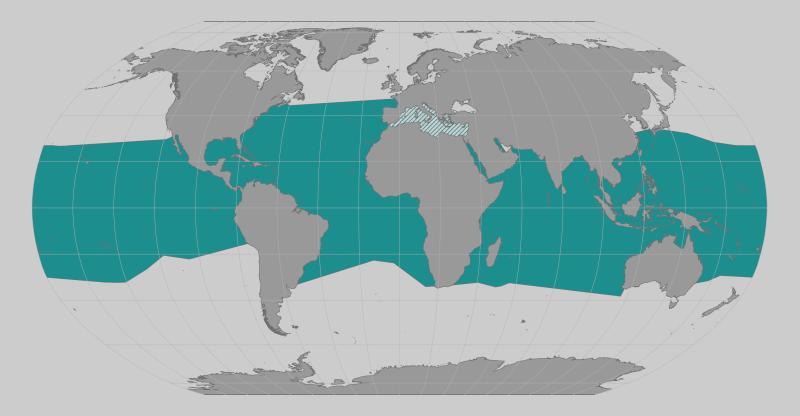 World map providing approximate representation of the oceanic whitetip shark's range
World map providing approximate representation of the oceanic whitetip shark's range
Lifespan & Reproduction
Generally, the maximum age of oceanic whitetip sharks is estimated to range 25-36 years.. Female oceanic whitetip sharks reach maturity between 6 and 9 years of age (depending on geographic location) and give birth to live young after a lengthy gestation period of 10 to 12 months. The reproductive cycle is thought to be biennial, with sharks giving birth on alternate years to litters ranging from 1 to 14 pups (average of 6), though some information suggests reproduction could be annual in some cases. There is also a likely correlation between female size and number of pups per litter, with larger sharks producing more offspring.
Threats
Commercial Fishing and Bycatch
The primary threat to the oceanic whitetip shark is incidental bycatch in commercial fisheries using longlines, purse seines, and gillnets (among other gear types). Because of their preferred distribution in warm, tropical waters, and their tendency to remain at the surface, oceanic whitetip sharks have high encounter and mortality rates in fisheries throughout their range.
Harvest for international trade
Their large, distinct fins are also highly valued in the international shark fin trade.
Scientific Classification
| Kingdom | Animalia | Phylum | Chordata | Class | Chondrichthyes | Order | Carcharhiniformes | Family | Carcharhinidae | Genus | Carcharhinus | Species | longimanus |
|---|
Last updated by NOAA Fisheries on 06/12/2025
Featured News
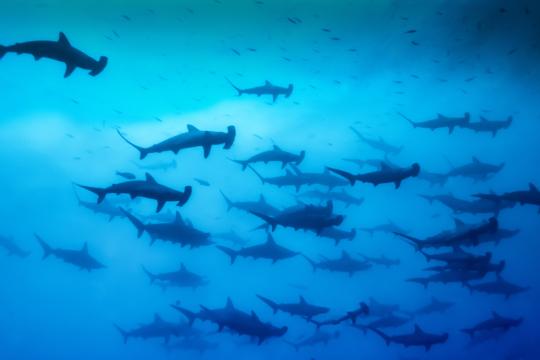
Global Extinction Risk for Sharks and Rays Is High, United States may Provide Haven
 Juvenile coho salmon. Credit: iStock
Juvenile coho salmon. Credit: iStock
NOAA Fisheries Releases 2023 Status of Stocks
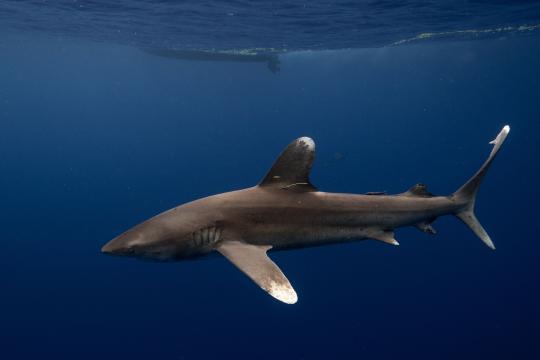 An oceanic whitetip shark swims near the surface of the water. Photo courtesy of John Carlson.
An oceanic whitetip shark swims near the surface of the water. Photo courtesy of John Carlson.
Oceanic Whitetip Sharks: A Plan for Recovery
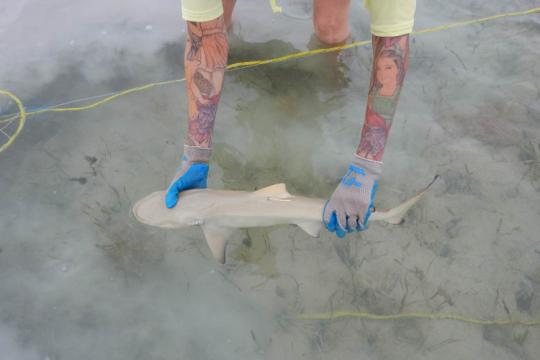 Previously tagged lemon shark Negaprion acutidens recaptured during survey
Previously tagged lemon shark Negaprion acutidens recaptured during survey
Management Overview
The oceanic whitetip shark is listed as threatened under the Endangered Species Act.
Additionally, the oceanic whitetip shark is listed under:
- Appendix II of the Convention on International Trade in Endangered Species of Wild Fauna and Flora (CITES)
- Annex II of the Protocol for Specially Protected Areas and Wildlife (SPAW).
The oceanic whitetip shark is also listed under Annex I of the Sharks Memorandum of Understanding on the Convention on Migratory Species (CMS).
Recovery Planning and Implementation
Recovery Action
Under the ESA, NOAA Fisheries must develop and implement recovery plans for the conservation and survival of listed species. The ultimate goal of each plan is to recover the species to the point at which it no longer requires the protections of the ESA and can be delisted.
We developed the Oceanic Whitetip Shark Recovery Plan based on available data and scientific literature, as well as input provided at two recovery planning workshops for the oceanic whitetip shark—one on April 23-24, 2019 in Honolulu, Hawaiߵi, and another on November 13 and 14, 2019 in Miami, Florida. The purpose of these workshops was to gather information, facts, and perspectives on how to recover the oceanic whitetip shark, including identifying potential recovery criteria and actions to address ongoing threats to the oceanic whitetip shark. Participants included federal and state agencies, scientific experts, commercial fishermen, conservation partners, and non-governmental organizations.
- Recovery Planning Workshop Agenda - Honolulu, Hawaiߵi (PDF, 3 page)
- Recovery Planning Workshop Summary - Honolulu, Hawaiߵi (PDF, 18 pages)
- Recovery Planning Workshop Agenda - Miami, Florida (PDF, 3 pages)
- Recovery Planning Workshop Summary - Miami, Florida (PDF, 21 pages)
We adopted the final Oceanic Whitetip Shark Recovery Plan in July 2024. The plan recommends the following major actions:
- Improve knowledge and understanding of oceanic whitetip shark population status, abundance trends, and genetic structure.
- Improve knowledge and understanding of oceanic whitetip shark distribution, movement, and habitat use.
- Improve knowledge and understanding of the demographics and life history of oceanic whitetip sharks.
- Minimize fisheries bycatch and mortality of oceanic whitetip sharks by determining and addressing the frequency of capture and severity of fishing interactions in commercial, artisanal, and recreational fisheries.
- Minimize fisheries bycatch and mortality of oceanic whitetip sharks in international fisheries and trade through enhanced international coordination and collaboration with relevant international organizations, such as Regional Fishery Management Organizations (RFMOs).
- Determine the effects of the international shark fin trade on oceanic whitetip shark populations in all management units, and take management actions to minimize, and/or eliminate if necessary, the amount of oceanic whitetip shark fins in trade.
- Improve species-specific monitoring and reporting of oceanic whitetip sharks in commercial and artisanal fisheries by RFMOs and individual countries to provide a better understanding of the effects of illegal, unreported, and unregulated (IUU) fishing, improve estimates of catch and discards, and measure progress towards recovery.
- Minimize fishing mortality of oceanic whitetip sharks through effective development, implementation, and enforcement of international and domestic measures, such as legislation and regulations.
- Develop and implement outreach and education strategies and programs to increase public and stakeholder (including fishermen) awareness on the status and recovery needs of the oceanic whitetip shark.
Learn more about the Oceanic Whitetip Shark Recovery Plan
Learn more about oceanic whitetip shark biology, ecology, status, and threats
Implementation
The Recovery Implementation Strategy is a flexible, operational document that steps-down the recovery actions in the recovery plan into more specifically defined activities that implement and support the recovery actions. The Recovery Implementation Strategy is intended to assist NOAA Fisheries and other stakeholders in planning and implementing activities to carry out the recovery actions in the recovery plan. The activities identified in the Recovery Implementation Strategy can be modified and adapted over time based on the progress of recovery and the availability of resources or new data or literature.
Learn more about the Oceanic Whitetip Shark Recovery Implementation Strategy >
Recovery Contacts
Kristen Koyama, Oceanic Whitetip Shark Recovery Coordinator
For more information on oceanic whitetip sharks in our regions:
Adam Brame, Southeast Region
Chelsey Young, Pacific Islands Region
Conservation Efforts
Retention Prohibition in Atlantic Waters
Commercial and recreational retention of oceanic whitetip sharks is prohibited in all U.S. federal waters of the Atlantic Ocean, Gulf of America (formerly Gulf of Mexico), and Caribbean Sea. Fishermen must release an oceanic whitetip shark immediately, without removing it from the water and in a manner that maximizes its chances of survival.
Learn more about Atlantic Highly Migratory Species
Research and Collaborative Conservation Projects
NOAA Fisheries is currently working with a number of external partners on collaborative conservation projects in multiple areas. Experiments on ways to reduce bycatch mortality and assess post release mortality rates for oceanic whitetip sharks caught in longline fisheries are being conducted in both the Atlantic and Pacific Oceans. Quantification of the percentage of fin trimmings that consist of oceanic whitetips and their incidence in shark fin markets is being conducted with the ultimate goal of assigning fin samples to ocean basin of origin, allowing for a better understanding where IUU fishing of this species is occurring.
Convention on International Trade in Endangered Species of Wild Fauna and Flora
At the 2013 meeting of the Conference of the Parties to the Convention on International Trade in Endangered Species of Wild Fauna and Flora (CITES), the Parties agreed to include oceanic whitetip sharks in Appendix II of CITES, with the listing effective on September 14, 2014. The inclusion of oceanic whitetip sharks in CITES Appendix II helps ensure that the international trade for this species is legal and sustainable.
The U.S. Fish and Wildlife Service is the government agency designated under the Endangered Species Act to carry out the provisions of CITES. NOAA Fisheries provides guidance and scientific support on marine issues given our technical expertise.
Key Actions and Documents
Last updated by NOAA Fisheries on 06/12/2025
Documents
Recovery Status Review for the Oceanic Whitetip Shark
Recovery Status Review for the Oceanic Whitetip Shark.
Recovery Implementation Strategy for the Oceanic Whitetip Shark
This document describes the detailed, stepped-down recovery activities necessary to implement the…
Recovery Plan for the Oceanic Whitetip Shark
The Recovery Plan for the Oceanic Whitetip Shark includes the recovery goals, objectives, criteria,…
Protected Species Handling, Release, and Identification Guidelines
This guide provides best practices for handling and releasing techniques for Pacific Island pelagic…
Data & Maps
American Samoa Longline Logbook Reports 2023
Logbook summary reports for the 2023 calendar year.
American Samoa Longline Logbook Reports 2022
Logbook summary reports for the 2022 calendar year.
Hawaii and California Longline Logbook Reports 2022
Logbook summary reports for the 2022 calendar year.
Hawaii and California Longline Logbook Reports 2021
Logbook summary reports for the 2021 calendar year.
Research
Northeast Shark Research
We conduct shark life history research and long-term monitoring activities essential for stock assessment and management.
Quantifying the Accuracy of Shark Bycatch Estimations in Tuna Purse Seine Fisheries
Scientists were strategically positioned during fishing sets in order to establish a reference…
Outreach & Education
Oceanic Whitetip Shark Identification Guide
Identification guide for protected oceanic whitetip sharks.
Protected Marine Species Identification Guide Southeast United States
This guide is intended for use by mariners in the identification and reporting of threatened and…
Oceanic Whitetip Shark Safe Release for Hook and Line Gears
Follow these procedures to safely release oceanic whitetip sharks.
Last updated by NOAA Fisheries on 06/12/2025